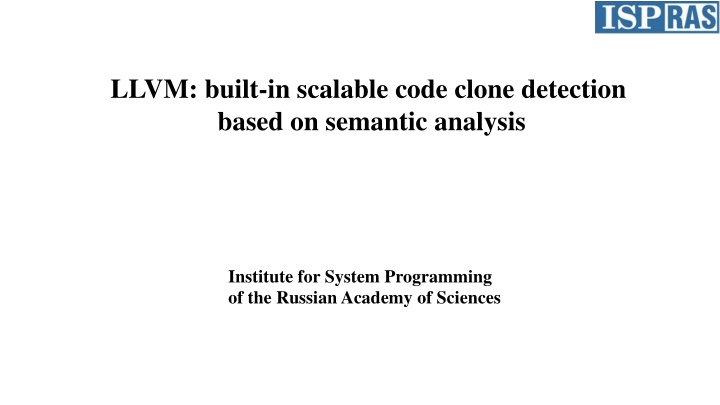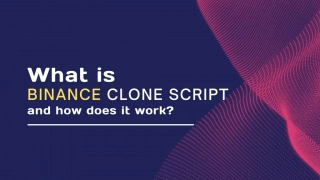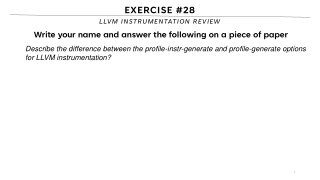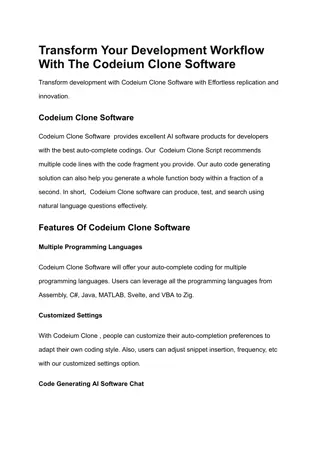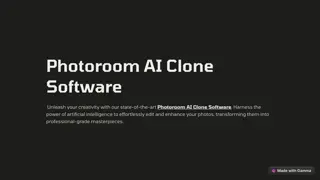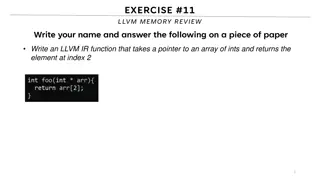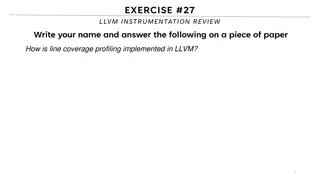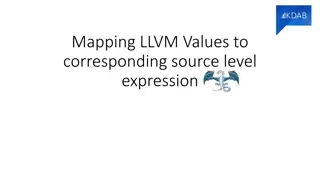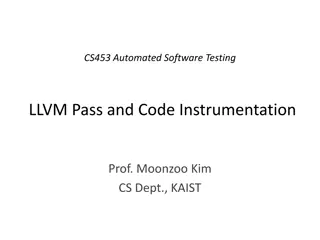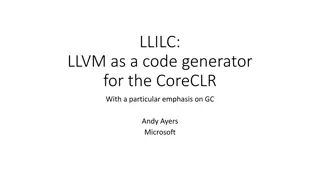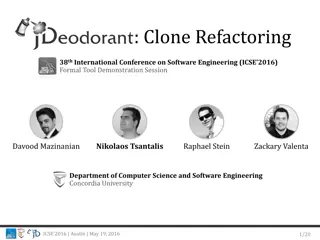LLVM: built-in scalable code clone detection based on semantic analysis
LLVM provides a scalable code clone detection tool for real projects, capable of analyzing up to a million lines of source code. The tool is semantic-based, leveraging Program Dependence Graphs for high accuracy. The architecture involves generating Program Dependence Graphs, optimizations, and serialization. Through automatic testing systems, the tool identifies identical code fragments with variations in whitespace, identifiers, literals, types, and comments. It offers advantages like compile-time generation of PDGs and scalability without extra dependencies analysis.
Download Presentation

Please find below an Image/Link to download the presentation.
The content on the website is provided AS IS for your information and personal use only. It may not be sold, licensed, or shared on other websites without obtaining consent from the author.If you encounter any issues during the download, it is possible that the publisher has removed the file from their server.
You are allowed to download the files provided on this website for personal or commercial use, subject to the condition that they are used lawfully. All files are the property of their respective owners.
The content on the website is provided AS IS for your information and personal use only. It may not be sold, licensed, or shared on other websites without obtaining consent from the author.
E N D
Presentation Transcript
LLVM: built-in scalable code clone detection based on semantic analysis Institute for System Programming of the Russian Academy of Sciences
Clone Types 1. Identical code fragments except the variations in whitespace, layout and comments. 2. Structurally/syntactically identical code fragments except the variations in identifiers, literals, types, layout and comments. 3. Copied fragments of code with further modifications. Statements can be changed, added or removed in addition to variations in identifiers, literals, types, layout and comments .
Formulation Of The Problem Design code clone detection tool capable for real projects analysis. Requirements : Semantic based ( based on Program Dependence Graph ) High accuracy Scalable (analyze up to million lines of source code)
Architecture : First part PDG for one module clang PASS PDG LLVM Generation of Program Dependence Graphs (PDG) PASS 1. Construction of PDG 2. Optimizations of PDG executable 3. Serialization of PDG
Example of Program Dependence Graph void foo() { int b = 5; int a = b*b; } %b = alloca i32 %a = alloca i32 store i32 5, i32* %b %2 = load i32* %b %1 = load i32* %b define void @foo() #0 { %b = alloca i32 %a = alloca i32 store i32 5, i32* %b %1 = load i32* %b %2 = load i32* %b %3 = mul nsw i32 %1, %2 store i32 %3, i32* %a } %3 = mul nsw i32 %1, %2 store i32 %3, i32* %a
Architecture : Second part PDG for one module Code Clone Detection Tool 1. Load dumped PDGs 2. Split PDGs to sub graphs 3. Fast checks (check if two graphs are not clones) 4. Maximal isomorphic sub graphs detection (approximate) 5. Filtration 6. Printing
Automatic Testing System List of PDGs for the project PDG 1 PDG 2 PDG n Modified list of PDGs PDG 1 PDG 2 PDG n/2 PDG j Check for clone PDG i PDG j PDG i PDG k
Advantages 1. Compile-time generation of PDGs. 2. No need of extra analysis for dependencies between compilation modules. 3. High accuracy. 4. Scalable to analyze million lines of source code ( / ++).
Results Copy00.cpp modified to get 3 types of clones. Test Name copy00.cpp copy01.cpp copy02.cpp copy03.cpp copy04.cpp copy05.cpp copy06.cpp copy07.cpp copy08.cpp copy09.cpp copy10.cpp copy11.cpp copy12.cpp copy13.cpp copy14.cpp copy15.cpp **CCFinder(X) yes yes yes yes yes yes no no no no no no no no yes yes MOSS yes yes yes yes yes yes no yes no no no no yes yes yes yes CloneDR yes yes yes yes yes yes yes yes no yes yes no yes yes yes yes CCD yes yes yes yes yes yes yes yes yes yes yes yes no yes yes yes Copy00.cpp 1: void foo(float sum, float prod) { 2: float result = sum + prod; 3: } 4: void sumProd(int n) { 5: float sum = 0.0; //C1 6: float prod = 1.0; 7: for (int i = 1; i<=n; i++) { 8: sum = sum + i; 9: prod = prod * i; 10: foo(sum, prod); 11: } 12: } **CCFinder(X) Chanchal K. Roy : Comparison and evaluation of code clone detection techniques and tools : A qualitative approach
Results Intel core i3, 8GB Ram. Source code lines (million lines) Compile time without PDGs generation (seconds) 5231 1965 81 Compile time with PDGs generation (seconds) Size of PDGs (megabytes) Firefox Mozilla LLVM + Clang Openssl 11 1.9 0.46 5525 2520 130 221 150 8.7
Results Similarity level higher 90%. Detection time (seconds) Detected clones False Positive Size of PDGs (megabytes) Firefox Mozilla LLVM + Clang Openssl 28219 20491 83 91 23 101 7 3 4 221 150 8.7
Results openssl-1.0.1g/crypto/cast/c_enc.c 141 : for (l-=8; l>=0; l-=8) 142 : { 143 : n2l(in,tin0); 144 : n2l(in,tin1); 145 : tin0^=tout0; 146 : tin1^=tout1; 147 : tin[0]=tin0; 148 : tin[1]=tin1; 149 : CAST_encrypt(tin,ks); 150 : tout0=tin[0]; 151 : tout1=tin[1]; 152 : l2n(tout0,out); 153 : l2n(tout1,out); 154 : } openssl-1.0.1g/crypto/bf/bf_enc.c 237 : for (l-=8; l>=0; l-=8) 238 : { 239 : n2l(in,tin0); 240 : n2l(in,tin1); 241 : tin0^=tout0; 242 : tin1^=tout1; 243 : tin[0]=tin0; 244 : tin[1]=tin1; 245 : BF_encrypt(tin,schedule); 246 : tout0=tin[0]; 247 : tout1=tin[1]; 248 : l2n(tout0,out); 249 : l2n(tout1,out); 250 : }
Results openssl-1.0.1g/crypto/bf/bf_ofb64.c 79 : n2l(iv,v0); 80 : n2l(iv,v1); 81 : ti[0]=v0; 82 : ti[1]=v1; 83 : dp=(char *)d; 84 : l2n(v0,dp); 85 : l2n(v1,dp); 86 : while (l--) 87 : { 88 : if (n == 0) 89 : { 90 : BF_encrypt((BF_LONG *)ti,schedule); 91 : dp=(char *)d; 92 : t=ti[0]; l2n(t,dp); 93 : t=ti[1]; l2n(t,dp); 94 : save++; 95 : } 96 : *(out++)= *(in++)^d[n]; 97 : n=(n+1)&0x07; 98 : } openssl-1.0.1g/crypto/des/ofb64ede.c 81 : c2l(iv,v0); 82 : c2l(iv,v1); 83 : ti[0]=v0; 84 : ti[1]=v1; 85 : dp=(char *)d; 86 : l2c(v0,dp); 87 : l2c(v1,dp); 88 : while (l--) 89 : { 90 : if (n == 0) 91 : { 92 : /* ti[0]=v0; */ 93 : /* ti[1]=v1; */ 94 : DES_encrypt3(ti,k1,k2,k3); 95 : v0=ti[0]; 96 : v1=ti[1]; 97 : 98 : dp=(char *)d; 99 : l2c(v0,dp); 100 : l2c(v1,dp); 101 : save++; 102 : } 103 : *(out++)= *(in++)^d[n]; 104 : n=(n+1)&0x07; 105 : }
Results openssl-1.0.1g/crypto/bn/asm/x86_64-gcc.c 468 : mul_add_c(a[0],b[1],c2,c3,c1); 469 : mul_add_c(a[1],b[0],c2,c3,c1); 470 : r[1]=c2; 471 : c2=0; 472 : mul_add_c(a[2],b[0],c3,c1,c2); 473 : mul_add_c(a[1],b[1],c3,c1,c2); 474 : mul_add_c(a[0],b[2],c3,c1,c2); 475 : r[2]=c3; 476 : c3=0; 477 : mul_add_c(a[0],b[3],c1,c2,c3); 478 : mul_add_c(a[1],b[2],c1,c2,c3); 479 : mul_add_c(a[2],b[1],c1,c2,c3); 480 : mul_add_c(a[3],b[0],c1,c2,c3); 481 : r[3]=c1; 482 : c1=0; 483 : mul_add_c(a[3],b[1],c2,c3,c1); 484 : mul_add_c(a[2],b[2],c2,c3,c1); 485 : mul_add_c(a[1],b[3],c2,c3,c1); 486 : r[4]=c2; 487 : c2=0; 488 : mul_add_c(a[2],b[3],c3,c1,c2); 489 : mul_add_c(a[3],b[2],c3,c1,c2); 490 : r[5]=c3; 491 : c3=0; openssl-1.0.1g/crypto/bn/asm/x86_64-gcc.c 535 : sqr_add_c2(a,7,0,c2,c3,c1); 536 : sqr_add_c2(a,6,1,c2,c3,c1); 537 : sqr_add_c2(a,5,2,c2,c3,c1); 538 : sqr_add_c2(a,4,3,c2,c3,c1); 539 : r[7]=c2; 540 : c2=0; 541 : sqr_add_c(a,4,c3,c1,c2); 542 : sqr_add_c2(a,5,3,c3,c1,c2); 543 : sqr_add_c2(a,6,2,c3,c1,c2); 544 : sqr_add_c2(a,7,1,c3,c1,c2); 545 : r[8]=c3; 546 : c3=0; 547 : sqr_add_c2(a,7,2,c1,c2,c3); 548 : sqr_add_c2(a,6,3,c1,c2,c3); 549 : sqr_add_c2(a,5,4,c1,c2,c3); 550 : r[9]=c1; 551 : c1=0; 552 : sqr_add_c(a,5,c2,c3,c1); 553 : sqr_add_c2(a,6,4,c2,c3,c1); 554 : sqr_add_c2(a,7,3,c2,c3,c1); 555 : r[10]=c2; 556 : c2=0; 557 : sqr_add_c2(a,7,4,c3,c1,c2); 558 : sqr_add_c2(a,6,5,c3,c1,c2); 559 : r[11]=c3; 560 : c3=0;
Thank You. Thank You.
